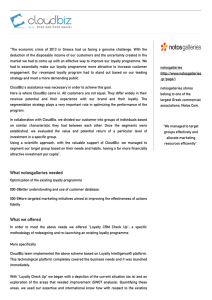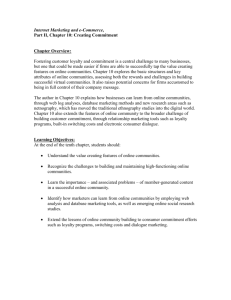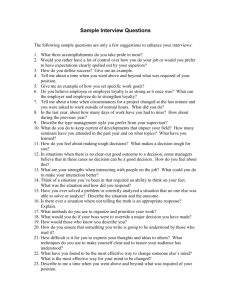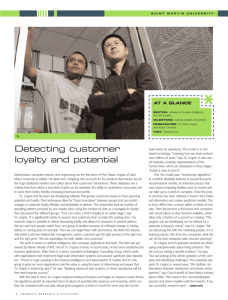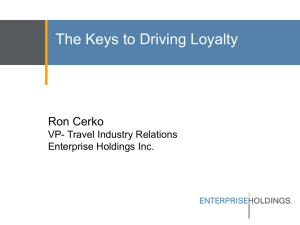Economic Profit Model - Customer Lifecycle, Llc
advertisement
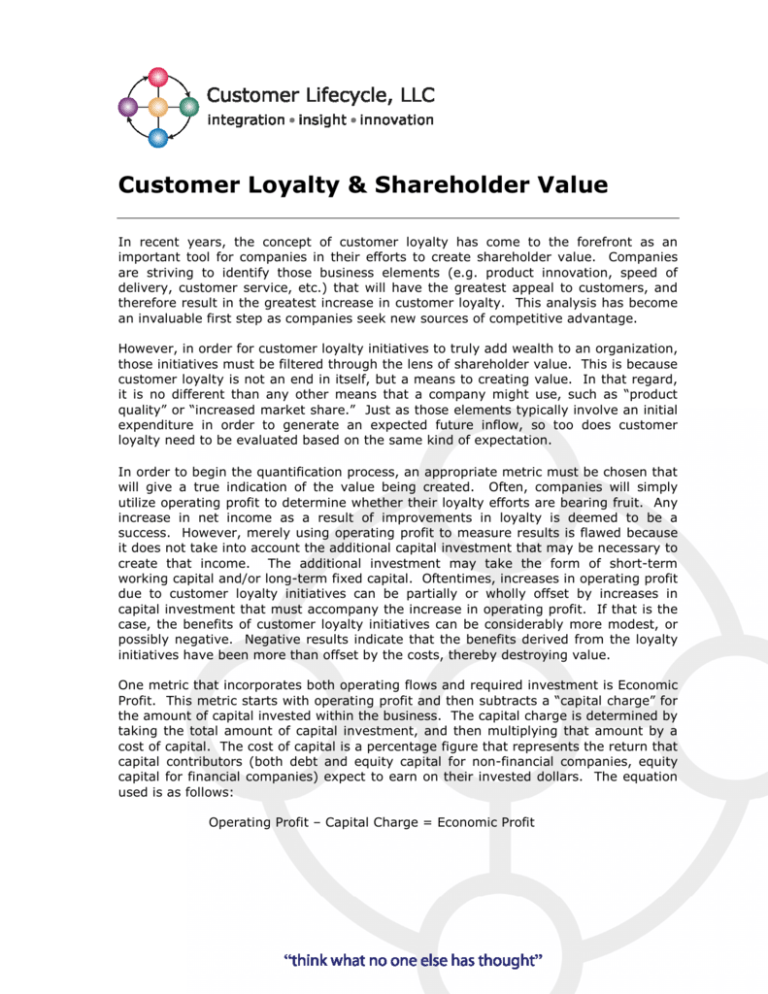
Customer Loyalty & Shareholder Value In recent years, the concept of customer loyalty has come to the forefront as an important tool for companies in their efforts to create shareholder value. Companies are striving to identify those business elements (e.g. product innovation, speed of delivery, customer service, etc.) that will have the greatest appeal to customers, and therefore result in the greatest increase in customer loyalty. This analysis has become an invaluable first step as companies seek new sources of competitive advantage. However, in order for customer loyalty initiatives to truly add wealth to an organization, those initiatives must be filtered through the lens of shareholder value. This is because customer loyalty is not an end in itself, but a means to creating value. In that regard, it is no different than any other means that a company might use, such as “product quality” or “increased market share.” Just as those elements typically involve an initial expenditure in order to generate an expected future inflow, so too does customer loyalty need to be evaluated based on the same kind of expectation. In order to begin the quantification process, an appropriate metric must be chosen that will give a true indication of the value being created. Often, companies will simply utilize operating profit to determine whether their loyalty efforts are bearing fruit. Any increase in net income as a result of improvements in loyalty is deemed to be a success. However, merely using operating profit to measure results is flawed because it does not take into account the additional capital investment that may be necessary to create that income. The additional investment may take the form of short-term working capital and/or long-term fixed capital. Oftentimes, increases in operating profit due to customer loyalty initiatives can be partially or wholly offset by increases in capital investment that must accompany the increase in operating profit. If that is the case, the benefits of customer loyalty initiatives can be considerably more modest, or possibly negative. Negative results indicate that the benefits derived from the loyalty initiatives have been more than offset by the costs, thereby destroying value. One metric that incorporates both operating flows and required investment is Economic Profit. This metric starts with operating profit and then subtracts a “capital charge” for the amount of capital invested within the business. The capital charge is determined by taking the total amount of capital investment, and then multiplying that amount by a cost of capital. The cost of capital is a percentage figure that represents the return that capital contributors (both debt and equity capital for non-financial companies, equity capital for financial companies) expect to earn on their invested dollars. The equation used is as follows: Operating Profit – Capital Charge = Economic Profit Customer Loyalty & Shareholder Value This Economic Profit metric can now be applied to determine which customers are creating value within the organization. While many companies feel that all customers must be creating value, it is clear that that value may be heavily skewed. Frequently, an Economic Profit analysis shows that only a relatively small amount of customers are creating most of the value within an organization, and that the rest of the customer base is either value neutral or is actually destroying value. Once the value of each customer has been determined, a company is now in a position to determine how and where its customer loyalty efforts should be directed. Drawing on other customer loyalty work that has determined which customer loyalty elements (e.g. customer service, product innovation, etc.) are likely to result in the greatest improvement in loyalty, a company can then target improvements in those elements that are of most importance to its most valuable customers. One of the key questions that arises in trying to use an Economic Profit approach to quantify customer loyalty initiatives is how this metric can be taken down to the customer level. While the calculation of Economic Profit at a company level is facilitated by existing consolidated financial statements, the calculation at the customer level can present many challenges. However, those challenges can be overcome by realizing that much financial information already exists at the lowest customer levels (e.g. revenue, cost of revenue, accounts receivable, etc.). Other financial elements can frequently be calculated by adopting an allocation process based on, for instance, dollar revenue, time spent per customer, etc. The resulting Economic Profit totals per customer, while not necessarily “perfect”, will usually be sufficiently accurate to allow a company to make value determinations regarding its customers. In addition, expenditures to improve customer loyalty can be evaluated based on expected increases in Economic Profit, and a “return on customer loyalty initiatives” can be developed. In order to reach this point however, an organization must devote the time and effort needed to analyze not only consolidated financial statements, but also the supplementary statements and documents that are the building blocks of those statements. By using an Economic Profit approach, a company can begin the process of analyzing its customers, as well as its customer loyalty initiatives, based on shareholder value. This framework will ensure that decisions that are made are ultimately viewed in the context of their impact on the wealth of the organization. Customer Lifecycle, LLC can assist you in constructing an Economic Profit model that makes sense for your organization. 2 Customer Loyalty & Shareholder Value About Customer Lifecycle, LLC www.customerlifecycle.us Customer Lifecycle, LLC is committed to helping companies avoid costly mistakes by focusing on thorough front-end planning, appropriate support for research execution, and especially in-depth deployment consulting and implementation at the back end. Outcomes are rigorous and balanced customer-focused performance metrics, improved financial results, and a superior total customer experience. Each stage in the customer lifecycle — acquisition, service, growth, retention — has its own unique challenges and solutions to address specific business issues. Customer Lifecycle, LLC helps both B2B and B2C companies plan and conduct research to accurately identify and measure customer requirements for satisfaction, loyalty and retention at every stage of the relationship and to deploy and integrate customer requirements for performance into the processes and internal performance metrics of the organization. Liaison We welcome any questions you may have about this thought piece. Please direct all inquiries to: karin a ferenz | principal direct: 630.412.8989 mobile: 630.235.9834 kaferenz@customerlifecycle.us james salter | principal karin a ferenz | principal direct: 856.910.8220 mobile: 609.605.8160 jsalter@customerlifecycle.us direct: 630.412.8989 mobile: 630.235.9834 kaferenz@customerlifecycle.us 3



